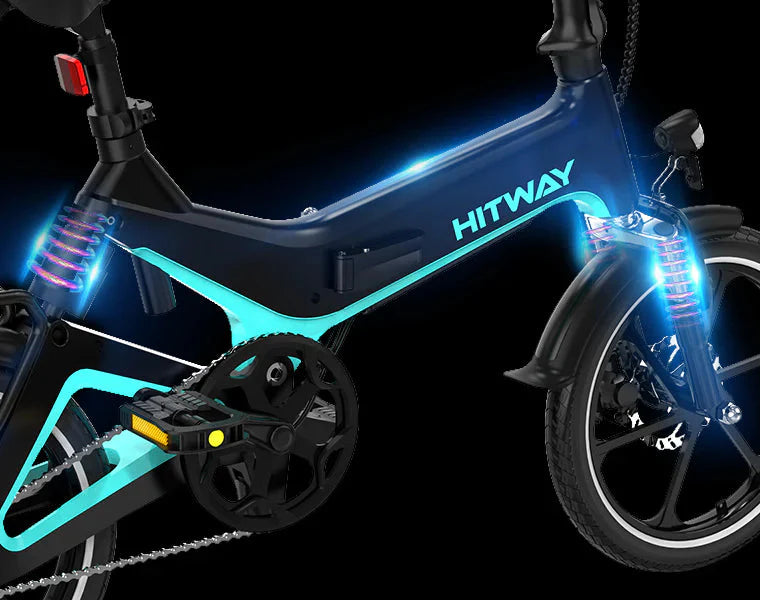
E-Bike Batteries: Everything You Need to Know About Charging & Lifespan
Share
E-bike batteries are the heart of your electric bicycle, dictating how far you can travel, how fast you can ride, and how long your e-bike will last. Understanding how to properly charge and maintain your battery is crucial for maximizing performance and lifespan. In this ultimate guide, we’ll cover everything you need to know about e-bike battery charging, lifespan, maintenance, and optimization.
Types of E-Bike Batteries
Before diving into charging and lifespan, let’s explore the most common types of e-bike batteries:
| Battery Type | Pros | Cons |
|---|---|---|
| Lithium-Ion (Li-Ion) | High energy density, lightweight, long lifespan | Expensive, requires proper care |
| Lithium Polymer (LiPo) | Lighter and more flexible design | Less stable, shorter lifespan than Li-Ion |
| Nickel-Metal Hydride (NiMH) | More eco-friendly than lead-acid | Heavier, less efficient than Li-Ion |
| Lead-Acid | Affordable | Heavy, low energy density, short lifespan |
Lithium-ion batteries are the most commonly used in modern e-bikes due to their high efficiency, long lifespan, and low maintenance requirements.
How to Properly Charge Your E-Bike Battery
Charging your e-bike battery correctly ensures better longevity and performance. Follow these steps:
1. Use the Right Charger
-
Always use the charger provided by the manufacturer to avoid damaging the battery.
-
Using an incorrect charger can lead to overheating, reduced capacity, or even fire hazards.
2. Charge in a Cool, Dry Place
-
Avoid charging in extreme temperatures (below 0°C or above 40°C).
-
Store and charge your battery in a well-ventilated, dry area to prevent overheating.
3. Partial Charging is Better Than Full Discharge
-
Avoid letting the battery fully deplete before charging.
-
Charge when the battery reaches 20-30% and unplug around 80-90% for maximum lifespan.
4. Don’t Leave the Battery Plugged in Overnight
-
Most modern batteries stop charging automatically, but prolonged charging may generate heat and reduce longevity.
5. Charge Regularly
-
If you’re not using your e-bike for an extended period, charge it at least once a month to prevent deep discharge.
Maximizing Your E-Bike Battery’s Lifespan
Proper care and maintenance can significantly extend the lifespan of your e-bike battery. Here’s how:
1. Avoid Extreme Temperatures
-
Hot weather can accelerate chemical reactions, leading to faster degradation.
-
Cold temperatures can reduce the battery’s efficiency and temporarily lower capacity.
2. Store Your Battery Correctly
-
If you’re storing your e-bike for long periods, keep the battery charged at 40-60% and store it in a cool, dry place.
-
Never store the battery fully charged or completely empty for extended periods.
3. Avoid Overloading Your E-Bike
-
Carrying excessive weight puts more strain on the battery and reduces its lifespan.
-
Ride at a consistent speed instead of frequent sudden accelerations.
4. Regular Maintenance & Inspection
-
Check the battery contacts for dirt, rust, or corrosion.
-
Clean with a dry cloth and ensure all connections are secure.
How Long Do E-Bike Batteries Last?
E-bike battery lifespan is measured in charge cycles (full charge and discharge). Here’s a general lifespan comparison:
| Battery Type | Average Lifespan (Charge Cycles) | Estimated Years (Moderate Use) |
| Lithium-Ion | 500-1000 cycles | 3-7 years |
| Lithium Polymer (LiPo) | 300-500 cycles | 2-5 years |
| Nickel-Metal Hydride (NiMH) | 300-500 cycles | 2-4 years |
| Lead-Acid | 200-300 cycles | 1-3 years |
Common Mistakes That Shorten Battery Life
Avoid these common mistakes to keep your battery in top condition:
-
Using an incompatible charger – Can damage battery cells.
-
Letting the battery fully deplete – Reduces capacity over time.
-
Overcharging – Generates heat, causing premature wear.
-
Riding aggressively – Sudden acceleration drains battery faster.
-
Exposing the battery to water – Can cause corrosion and short circuits.
Signs That Your E-Bike Battery Needs Replacement
Over time, e-bike batteries lose efficiency. Here are some signs that it’s time for a replacement:
-
Significant reduction in range – If your battery drains much faster than before.
-
Takes longer to charge – Indicates reduced capacity.
-
Swollen or damaged battery casing – A sign of internal damage.
-
Frequent overheating – Can be dangerous and should not be ignored.
FAQs About E-Bike Batteries
1. How Far Can an E-Bike Battery Last on a Single Charge?
It depends on factors like battery capacity, terrain, rider weight, and pedal assistance. On average:
-
250Wh battery – 15-30 miles
-
500Wh battery – 30-60 miles
-
750Wh battery – 50-80 miles
2. Can I Replace My E-Bike Battery with a Higher Capacity One?
Yes, but ensure the battery is compatible with your e-bike’s motor and controller.
3. Is It Safe to Charge an E-Bike Battery Overnight?
While most modern e-bike batteries have auto shut-off, it’s best to unplug once fully charged to avoid unnecessary wear.
4. What Happens If I Overcharge My Battery?
Overcharging can cause excessive heat buildup, shorten lifespan, and in extreme cases, pose a fire hazard.
5. Can I Ride My E-Bike in the Rain?
Most e-bike batteries are water-resistant, not waterproof. Light rain is fine, but avoid deep puddles and heavy downpours.
Final Thoughts
Proper charging and maintenance are key to maximizing the lifespan of your e-bike battery. By following the best practices outlined in this guide, you can enjoy longer rides, fewer replacements, and better performance from your electric bike.
For more e-bike tips, maintenance hacks, and industry updates, stay tuned to our blog!
🚴♂️ Happy Riding! 🔋
